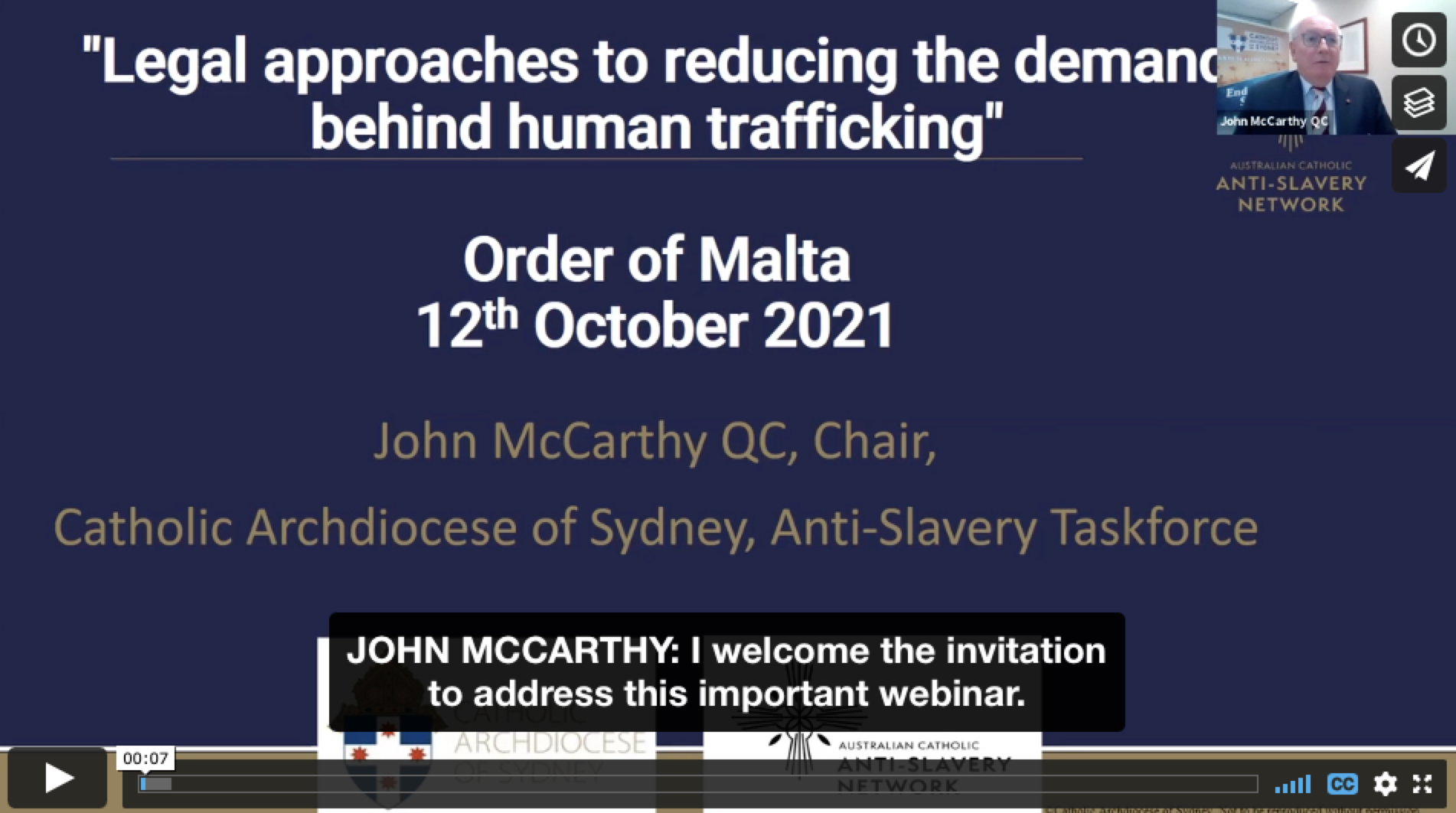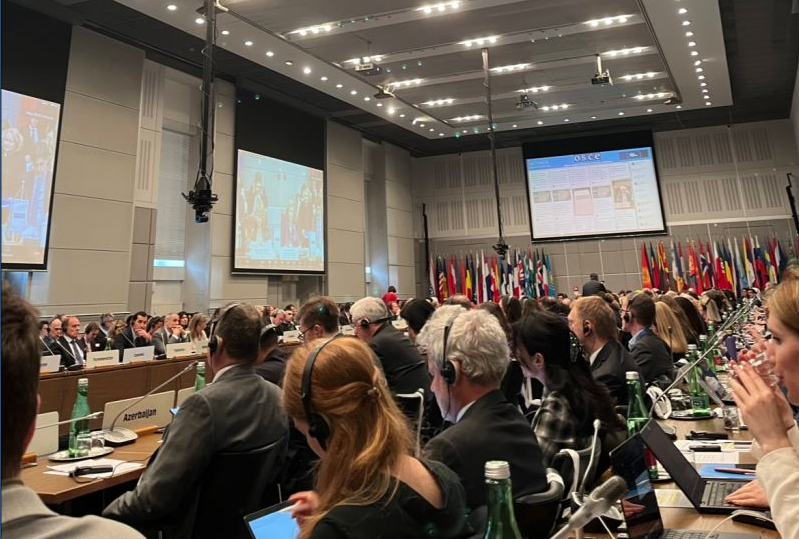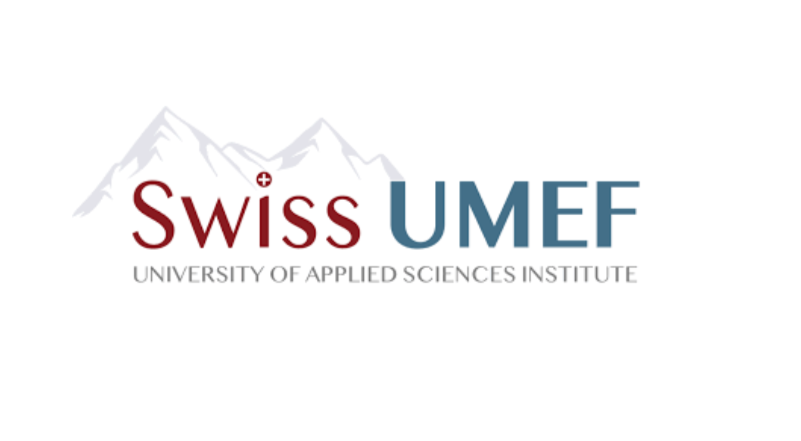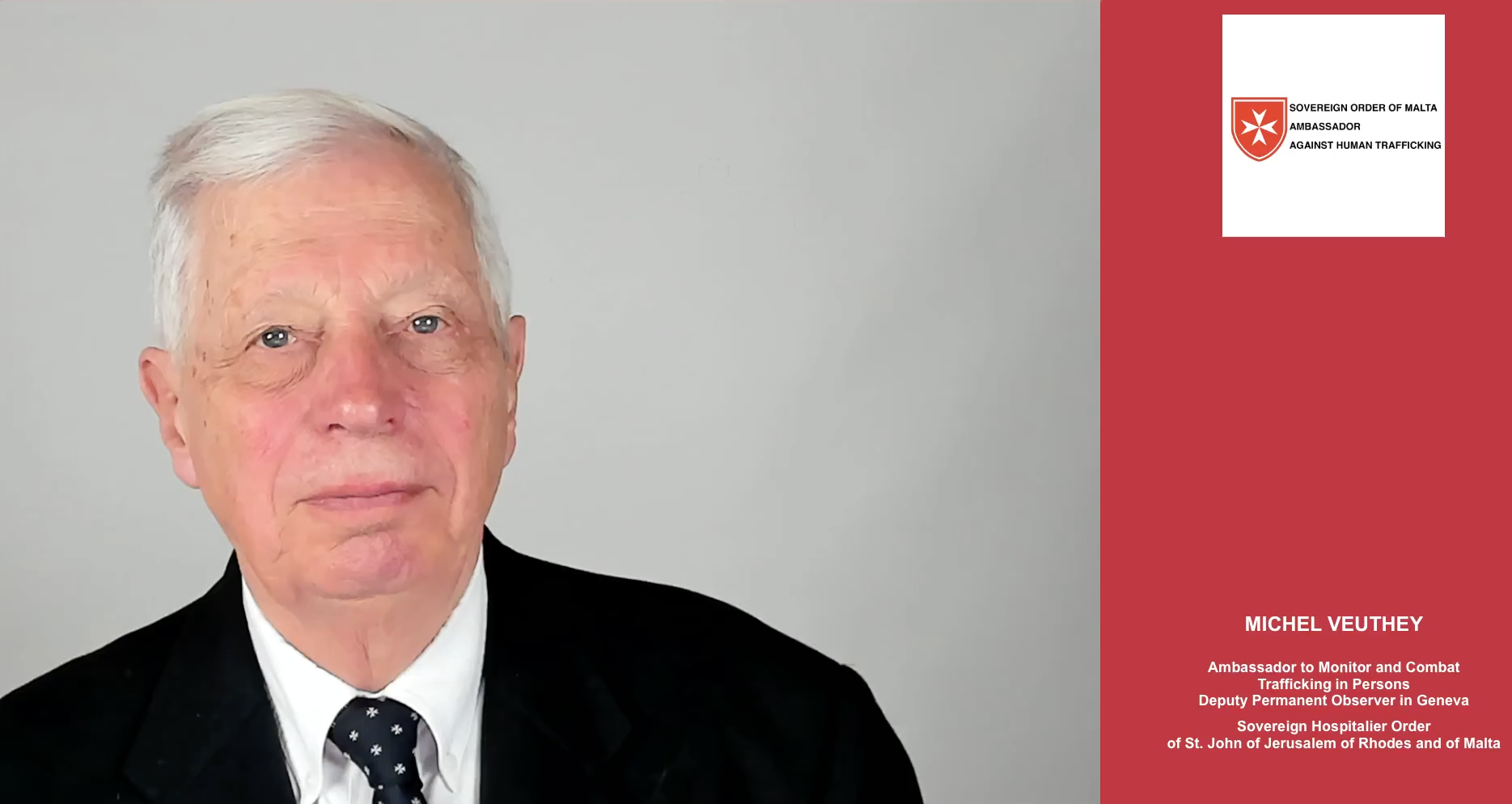ADLAUDATOSI WEBINARS
JOHN MCCARTHY’ INTERVENTION
12 OCTOBER 2021 — LEGAL APPROACHES TO REDUCING THE DEMAND BEHIND HUMAN TRAFFICKING
JOHN MCCARTHY: I welcome the invitation to address this important webinar. I thank Michel Veuthey for this invitation on behalf of the webinar sponsors. The entire series has been an important international contribution to knowledge and analysis in respect of modern slavery and human trafficking. An objective of this webinar is to explore and consider responses to modern slavery and human trafficking by institutions and agencies that procure goods and services for use, not for further sale. The cost of goods and services involved in such procurement represents a measure of demand of the procurer for the goods and services from particular sources, or the supply.
That’s a roundabout way of saying, the context I’m addressing is not one of reselling or on-selling or acting as a broker or middleman. Processes and procedures for procurement of goods and services not being tainted with modern slavery, including human trafficking and forced labour, is to eliminate or reduce the demands for goods and services so tainted and thereby exclude exploiter suppliers. If such arrangements include many procurers in either the public or private sector, the whole market for goods and services tainted with modern slavery is rapidly undermined. Catholic institutions and agencies in countries such as Australia are classic demand procurers of goods and services for their mission, whether health, education or welfare. Their changed patterns of procurement excluding slavery-tainted goods and services can influence regional and national suppliers not desiring to be excluded from these contracts. Such supplier response would be accentuated by public authorities adopting similar policies. In 2018, the Global Slavery Index estimated that 40.3 million people were experiencing modern slavery, including an estimated 15,000 people in Australia. It is also estimated that 16 million of these people are trapped in the supply chains of private companies producing goods and services for the global market.
It is likely that most of us have purchased electronics such as mobile phones and computers; food such as tea or coffee, chocolate, frozen fish; textiles such as clothing, shoes, linens; or other items such as furniture, jewelry, makeup made by people enslaved in factories, illegal fisheries, forests, on farms and in mines, to name a few. The Catholic Church in order to carry out its mission through its agencies and institutions must be a procurer of goods and services. In Australia, the Catholic leadership is at the forefront of campaigns to exclude slavery-tainted goods and services from procurement in the Australian economy. This is the example generated by the policies and practices of Catholic agencies and institutions in Australia. An important purpose is that Catholic anti-slavery practice may come to influence Australian civil authorities and corporate leaders. The presence of modern slavery is a somber and difficult challenge for any organisation to address, whether a Nation State, a global corporation or the universal Church. More people are trapped in modern slavery than at any time in history. Today, the risk that a product or service is tainted with slave labour somewhere in the supply chains occurs in almost all industries, and all countries are affected. So too, are the supply chains of Catholic entities in Australia.
The profits alone from human trafficking and modern slavery circulating the global economy are estimated to be, in excess, of US dollars 150 billion. The Holy Father Pope Francis has referred to this astounding figure as “blood money”. Law enforcement across every jurisdiction struggles to have significant effect on these criminal activities. If the primary focus of enforcement continues and remains on prosecutions, it will be impossible to reach the SDG 8.7 Target before the next century, let alone in 2030. That is the challenge. Yet we believe and have faith that we can make a difference. I speak today to the experience of the Church and its institutions in Australia in relation to modern slavery and human trafficking.
What I want to describe to you is the particular pathway in Australia, which has led us to a national network of Catholic agencies, Dioceses and personnel working together to eradicate modern slavery from our operations and supply chains.
This Catholic Australian experience can, I hope, inform and encourage you on your pathway as Catholics all over the world move towards our Holy Father’s objective of eradicating modern slavery in our generation. Indeed, our journey in Australia begins with the inspiration of the Holy Father, who had a major role in the United Nations Sustainable Development Goal 8.7 to eradicate forced labour, modern slavery, human trafficking and child labour by 2030. Pope Francis has emphasized that buying goods is not just a commercial matter. Our purchasing habits have deep moral dimensions. As the largest employer in Australia outside the public sector, the Catholic Church is in a pivotal position to lead the momentum for change on this critical issue. 5.1 million people across Australia identify as Catholics. Schools, hospitals, residential aged care facilities, universities, investment and insurance funds are just some of the Catholic institutions that touch the lives of millions of Australians, regardless of faith. One in five Australian school children are educated in Catholic schools. One in ten hospital patients and aged care residents receive care in Catholic health facilities. The extent of Catholic supply chains is therefore highly significant. Indeed, the major exposure to modern slavery by the Church in Australia is related to procurement decisions, to the buying of goods and services and investments. Today, I’m pleased to say that entities representing 70% of Catholic activity in Australia have joined in the collaborative exercise we call ACAN: the Australian Catholic Anti-slavery Network. These Catholic institutions have begun programs and work to become more slavery-free every year between now and 2030. We know an enormous effort will be required to achieve these goals. Catholic institutions are working together and taking the lead.
We are calling on Australians and the Australian institutions to come with us so that together we can eradicate modern slavery in our own country. Eradication has been a persistent and consistent message of Pope Francis since his election to the Chair of St. Peter in 2013. It is a message directed as much to Church leaders as it is to national leaders and civil authorities. In proposing action in the Sydney Archdiocese, Archbishop Anthony Fisher has stated: “It is not enough for groups such as Churches to lecture or exhort the rest of the community in such matters. We must demonstrate our own willingness to act where we can.” Archbishop Fisher subsequently appointed an Anti-slavery Taskforce of which I am the Chair and issued us with the strong mandate to establish a road map to eradicate modern slavery and human trafficking from the operations and supply chains of the Sydney Archdiocese. We gave our first report to the Archbishop in January 2018, and on Saint Bakhita’s Day 8 February 2018 Archbishop Fisher publicly announced that he had accepted the recommendations of the Taskforce. This far reaching framework, which is now being implemented widely amongst Australian Catholic entities, seeks to bring about change in the areas where the Church has the most capacity to influence change in our own operations and supply chains. The Taskforce Executive has developed and is implementing a Risk Management Program for Catholic entities. The Taskforce has also worked closely with Governments and legislators with the view to ensuring that legislation and public procurement policy includes human rights due diligence throughout supply chains. In 2018 our work received a major boost when Australia’s Modern Slavery Act came into force. This Act was developed through extensive consultations, including the Australian business community and civil society, including the Catholic Church.
Some key points of the Australian legislation are: 1. It applies to at least 3000 entities, including foreign entities. 2. It applies to an entity with annual consolidated revenue of at least US $75 million. 3. It applies to Australian Government procurement. 4. It applies to not-for-profit organisations such as Churches and universities.
The Modern Slavery Act also applies to Catholic Church entities. In response to the mandatory reporting requirements, the Taskforce convened a National Conference in July 2019 on eradicating slavery from Catholic operations and supply chains. It was this Conference that recommended the establishment of the Australian Catholic Anti-slavery Network ACAN. ACAN’s activities, coordinated by the Anti-slavery Taskforce, have become the embodiment of Catholic commitment to eradicating modern slavery risk from Catholic operations and supply chains in Australia. One of the very important aspects of ACAN is that it is a forum for Catholic entities to work collaboratively, sharing knowledge and building capacity among the designated Modern Slavery Liaison Officers. Together, ACAN participants are taking practical and direct action to address modern slavery risks in operations and supply chains.
The scale is significant. As I mentioned, Catholic entities represent 70% of Catholic activity, an annual consolidated revenue of over Australian dollars 23 billion, with expenditure on goods and services, not salaries, of over 6 billion Australian dollars. Together, we analyze that revenue through a Risk Management Program and areas of risk and high spend were identified and categorized. Collectively as purchasers of goods and services, Catholic entities have committed to work with suppliers to improve labour practices in Australia. The high risk areas for ACAN entities are construction and medical supplies. ACAN’s Risk Management Program shared among the 40 participating entities involves policy, supplier contract clauses, training for staff and suppliers, as well as 30 different templates, tools and resources. All of the resources are shared via the ACAN website, in monthly webinars and in regular communications. Australian legislation requires reporting entities to specify remediation programs and processes that are following in relation to incidents and victims of modern slavery.
ACAN has responded to this requirement by launching a program called Domus 8.7, a comprehensive one-stop shop and confidential advice service for Church, community and business to access expertise as well as socio-legal support services for victims. This has been a short overview of the work we are doing in a very busy space for the purpose of reducing and redirecting demand for goods and services so that Catholic procurement is not of goods tainted with modern slavery. The Catholic Church in Australia is at the forefront of programs and efforts to eradicate modern slavery in our generation, which is so much desired by Pope Francis. Australian Catholics fervently pray that their work and programs will influence the wider Church and the wider world as pathways to eradicating modern slavery. We also strongly believe that our work and programs are Catholic Social Teaching in action. I congratulate Michel Veuthey and his distinguished sponsors for the presentation of this webinar series, which is of high quality and enduring importance. The anti-slavery cause worldwide is indebted to all of you.




